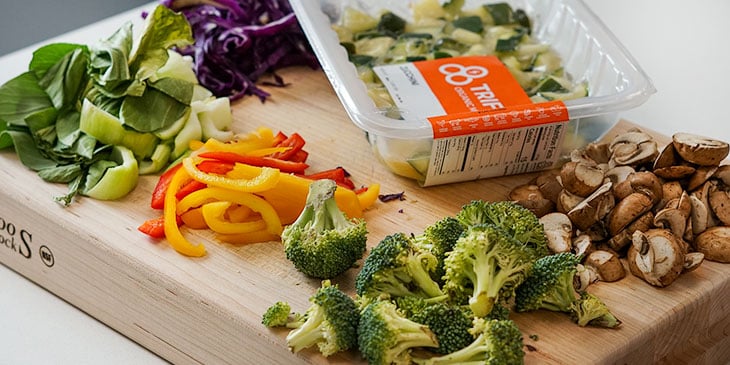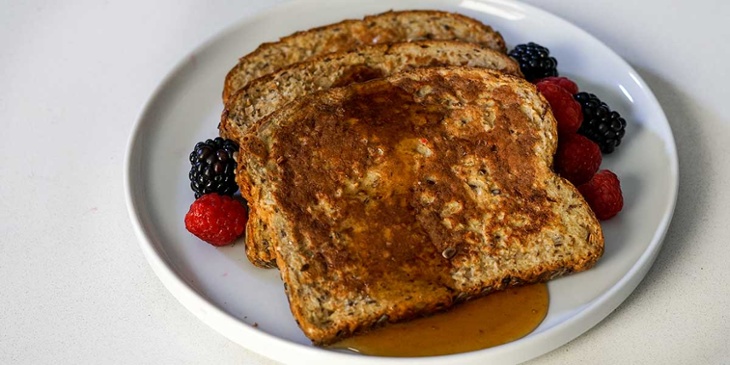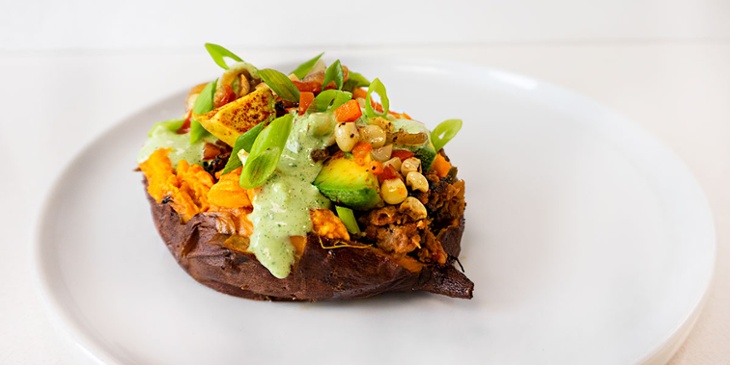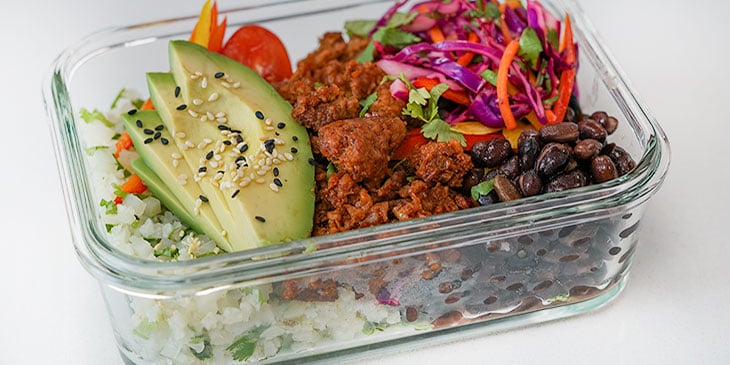This article provides everything you need to know about the flexitarian diet and how to do it right, including potential benefits, what foods and products to eat and what to limit, and a one-week meal prep guide packed with delicious recipes.
In this article we explore everything you need to know about the Flexitarian Diet including:
- What foods to eat and what to limit
- Potential health benefits
- Potential health risks
- 3 Tips to Get You Started
- One Week Meal Plan
What is the Flexitarian Diet?
The Flexitarian diet is another variation of plant-based diets that was marketed by registered dietitian nutritionist, Dawn Jackson Baltners who published The Flexitarian Diet Book in 2008 after hearing the word 'flexitarian' on the American Dialect Society’s word of the year list.
The American Dialect Society defines a flexitarian diet as a, “vegetarian who occasionally eats meats” (1).
There are several reasons that someone may consider transitioning to this type of meal plan:
- potential weight loss and health benefits
- wants to eat more fruits and vegetables
- tends to be more budget friendly
- Ethical reasons such as animal wellfare or environmental sustainability
The Flexitarian diet is similar to a vegetarian diet or vegan diet except meat is not completely off the table, helping you be more flexible with your eating plans but intentional with your food choices. It is basically a fancy and more intentional word for an omnivore diet.
The flexitarian diet is more of a food philosophy, all you have to do is eat more plants, slowly limit your consumption of meat, and do the best you can (2).
What Foods Will You Be Eating?

To follow a flexitarian diet aim to reduce your meat consumption while increasing your intake of fruits and vegetables.
How often you eat meat in a flexitarian diet is up to you, you can gradually decrease your meat centric meals to 0 or choose to reduce the portion size of meat in some of your meals.
Blatners recommends consuming smaller portion sizes of meat, no more than 4 ounces of meat per meal, for reference thats about the size of the palm of your hand.
To follow a flexitarian diet focus on adding more of the following:
- Plant-based meats: tofu, tempeh, legumes, lentils
- Fruits and vegetables: carrots, sweet potatoes, brussels sprouts, cauliflower squash (Any starchy or non-starchy vegetable you’d like)
- Whole grains: farro, quinoa, teff, buckwheat
- Dairy or plant-based milk alternatives
- Healthy condiments such as fresh herbs and spices, seasonings, salsa, mustard, nutritional yeast, and sweetener substitutes
Other ingredients to stock your fridge and pantry with may include nuts, seeds, and healthy fats to help you maximize your meal prep.
Whatever you decide to stock your pantry and fridge with for your meal prep, here are a few simple guidelines for how to choose quality food products:
- Buy locally grown foods from a farmers market or community supported agriculture (CSA’s)
- Purchase organic when possible
- Limit consumption of GMO’s
- When you do choose to consume animal products if possible try to choose 100% grass-fed meats, pasture raised eggs & poultry, and sustainable sourced fish
Potential Health Benefits of the Flexitarian Diet
There is no clear scientific evidence supporting potential health benefits from following a Flexitarian Diet because the term is so broad and applies to various diets that typically consume little to no meat.
However, we do know that a generic western diet, filled with a high consumption of red and processed meat, refined carbohydrates products, and high caloric intake may be associated with increased risk of cardiovascular disease and the development of other chronic conditions.
A well planned flexitarian diet will be similar to a vegetarian diet or semi-vegetarian diets, lush with whole vegetables, fruits, and whole-grains, and typically low in fat, processed foods, cholesterol, salt, animal products, and sugar (3).
Flexibility is the big pro of following a flexitarian diet, it's just a fancy name for a food plan that's fluid enough for you to plan around your individual nutrition goals and encourages you to consume more whole fruits and vegetables.
The health benefits of following a flexitarian meal plan will vary from person to person based on the quality and quantity of what you are eating.
Evidence suggests that diets focused on the consumption of nutrient-dense plant foods while minimizing processed foods, added sugars, oils, and meat may help reduce the risk of heart disease, diabetes, obesity, and high blood pressure (3,4).
Flexitarian Diet for Weight Loss
Because a well-planned flexitarian diet incorporates eating foods high in fiber and nutrient dense fruits and vegetables it is speculated it may have the same health benefits as vegetarian or vegan diets including weight loss.
Many people transitioning from a traditional American diet, or S.A.D. diet, may experience weight loss simply from the fact they are consuming less processed products and high-saturated fat foods and becoming more intentional with their diets.
A well-planned flexitarian diet could be a diet high in nutrient dense foods and fiber but low in saturated fat; these kinds of diets may help with weight loss and weight control along with being linked to improved appetite control. (5,6).
A large cross-sectional longitudinal study following over 90,000 people proposed that people who reduce meat in their diets typically also engage in other non-dietary lifestyle habits that promote weight loss and health (6).
This kind of dietary protocol can be called flexitarian, whole-foods plant based, or whole foods diet; there are many names for diets rich in whole-foods and nutrient dense foods.
At the end of the day it doesn't matter what you call your diet, as long as you feel like it is the best diet for you.
Flexitarian Diet for Cardiovascular Disease
Vegetarian diets may be associated with lower risk for cardiovascular risk factors such as obesity, hypertension, and type 2 diabetes, but because the term applies to a board range of diets many people may not experience the same effects on health (4).
Eating more fruits and vegetables increases your intake of beneficial nutrients and fiber, which can contribute to a lower risk of cardiovascular disease by lowering blood pressure and low-density lipoprotein, cholesterol, reducing inflammation, and improving glycemic control (4).
Anyone eating more vegetables and fruits while limiting their consumption of meat and animal products, similar to eating a heart healthy meal plan, may experience the benefits listed above but again, this will vary from person to person.
Considering that some processed foods such as oreos and potato-chips can be classified as 'plant-based', the flexitarian diet encourages us to focus on eating a healthy and well-balanced diet with intentional food choices.
Flexitarian Diets for Diabetes Management
Eating a low-fat, plant-based meal plan has been effective at treating diabetes potentially through improving insulin sensitivity and decreasing resistance (7,8).
Several large studies and clinical trials suggests the beneficial effects of a plant based diet on body weight, glycemic control, and cardiovascular risk factors for patients already diagnosed with type 2 diabetes (8).
Further studies are needed to explore the possible connection between eating a vegetarian diet and diabetes prevention as both diet and lifestyle play a role.
Flexitarian diets may mimic some qualities of plant-based or meat free diets, but again there is currently no research to support this specific diet for the management of Diabetes.
Upgrade your meal prep and build out your pantry with the best foods for Type 1 and Type 2 Diabetes.
Cons of Following a Flexitarian Diet
It can be challenging to plan a nutritionally balanced plant-based diet that meets 100% of your nutrition and energy needs, expect to spend more time in your kitchen and planning your meals.
Additionally, if you're suffering from an underlying condition affecting nutrient absorption and production you could be at risk for micronutrient deficiencies.
Here is a list of common nutrients to be aware of that may be difficult to achieve an adequate intake without a well-curated meal prep strategy or vitamin supplementation.
- Iron
- Vitamin B12
- Calcium and Vitamin D
- DHA and EPA Omega-3 Fatty Acids (especially if you are not consuming fish)
- Protein
Plant Based Iron May Not be Absorbed as Well
Many plants contain iron in small amounts such as cashews, spinach, kidney beans so beans and oatmeal but this iron is not as bioavailable compared to iron found in meat sources, and you may also have to consume larger portion sizes of plants to meet your individual needs (7).
Because iron from plant sources has a lower bioavailability, individuals who follow strict plant-based diets may be at risk for low iron stores or deficiencies, so consult with your primary care provider if you have any concerns.
Iron is essential for proper red blood cell function and growth; it helps carry oxygen to every cell in your body.
Plants are Low in Vitamin B12
Vitamin B12, and all of the B-vitamins each contribute uniquely in their own way to support our health; they are involved in functions ranging from energy production to DNA synthesis.
It's a common 'buzz-word' when discussing the potential risks of a plant-based diets for multiple reasons, the top being that we still have much to learn when it comes to understanding how our bodies absorb and synthesize B12.
Current evidence suggests that we may only absorb up to 50% of the B12 we get through supplementation and potentially less through diet alone but this will vary person to person (9).
High amounts of B12 can be found naturally in animal sources but there is limited evidence suggesting that B12 can be found naturally occurring in plant sources; animal sources of B12 are also thought to be better absorbed (9).
Common animal sources of B12 Include:
- Clams
- Mussels
- Salmon
- Beef
- Eggs
- Dairy
- Chicken
Current evidence suggests that some plants such as mushrooms, spirulina, and fermented food items including sauerkraut and tempeh may contain B12 source of B12 but there is not enough data to support their role in supplementation or preventing deficiency (10).
Building a solid meal prep routine can help you transform your diet and meet all your macro and micronutrient needs.
Should You Try a Flexitarian Diet?
As much of a lifestyle as a diet, the Flexitarian Diet is perfect for anyone intending to incorporate more vegetables into their diet and slowly limit their intake of meat.
Its a great way to get more intentional with your meal prep while increasing your consumption of nutrient-dense foods utilizing your diet as foundation of optimal health.
A lot of individuals see significant improvements in health from a plant-based diet due to the increase in nutrition from consuming more nutrient dense foods like plants.
At the end of the day assessing your personal health goals and current dietary habits will help you determine if the Flexitarian Diet is right for you.
Anyone who decides to adopt more of a plant-based diet may experience the following possible benefits (7):
- lower body weight
- decreased risk of inflammation and cancer
- reduction in their risk of death from heart disease
- reducing reliance on medications to treat chronic conditions
The potential weight loss and health benefits associated with eating a well planned flexitarian diet come from a balanced diet high in nutrient-dense plant foods while low in refined carbohydrates and animal foods, specifically meats (4).
Changing your diet is also choosing to transform your way of life; tailor your meal plan to your goals and strive towards optimal health.
How to Get Started
This meal plan helps you rethink how you plan your meals by transitioning from meat as the star of the show to more of a condiment while more plant-based options take the main stage.
Here are three great tips for transitioning to a flexitarian diet.
1. Plan Your Meal Prep Around Your Health Goals
The better you get at planning a menu that matches your nutritional needs and health goals, the less food you tend to waste, and ultimately the better results you see regardless of being a flexitarian, vegetarian, vegan, or omnivore.
Understanding your goals and what motivates you will help you build a sustainable food plan and get results.
Are you looking for weight loss, muscle gain, or overall better health?
Once you identify your big-picture health goal you, learn how many calories you should be eating each day and how much food that actually translates to.
Although a traditional Flexitarian Diet may not have you tracking calories, figuring out exactly how many calories you need to consume each day can help you track your food intake and manage your health journey.
Try this free calorie calculator to get your total daily energy expenditure (TDEE) in a few minutes:
Get familiar with food portioning tools like measuring cups, spoons, or even a food scale. Then build your meal plan and shopping list around the quantity you actually eat.
2. Start off with Meatless Mondays
In her book, Baltners suggests those transitioning to a flexitarian diet start off with 2 meatless days a week. The other 5 days limit consumption to 1 meat-centric meal a day with no more than 4 oz per meal.
When choosing the best plant based proteins you’ll want to consider the protein density of the food (how many grams of protein it has per calorie), its nutritional value, and how it fits into your overall dietary goals.
Many whole food plant proteins also tend to be a source of healthy fats, fiber, and essential nutrients - making them an excellent nutrition choice. However, their high amounts of carbs and fats can make balancing your plant based macros a little trickier and lower their overall protein density.
Substitute out the meat in recipes you love for plant-based protein sources such as:
- Soy
- Edamame
- Lentils
- Peas
- Black Beans
- Tempeh
At the end of the day, eat what you love, if you don't enjoy the food then you probably won't stick with it.
3. Rethink Your Plate
Reduce your intake of animal proteins by increasing the amount of fruits and vegetables on your plate along with a small portion of whole grains such as quinoa, brown rice, or whole grain pasta.
Increasing your vegetable intake can get repetitive, to ensure variety check out your local farmers market for some seasonal inspiration in your meal prep. You can also bulk up on leafy greens such as kale, spinach, collard greens, swiss chard, arugula, and dandelion greens!
If you don't have time to meal prep or need to eat healthy on a budget, purchasing frozen vegetables is your second best option to fresh.
One Week Flexitarian Meal Plan with Plant Based Recipes
To get you started off following a flexitarian meal plan we created a simple one-week Flexitarian meal prep guide complete with meatless meals for breakfast, lunch and dinner.
These recipes are plant-based and nutritional balanced for optimal flavor and meal prep planning ease.
7 Day Flexitarian Menu |
|
|
Breakfast |
Cheesy Tofu Scramble With Pistachio Pesto Or |
|
Lunch |
Or |
|
Dinner |
Portobello Mushroom Pot Roast Recipe Or |
Flexitarian Breakfast Recipes

- High Protein Vegan French Toast Recipe
- Sweet Potatoes and Greens Breakfast Hash Recipe
- Breakfast Muesli Recipe
Vegan and Vegetarian Lunch Recipes

- Vegan Southwest Sweet Potato Recipe
- Curried Cauliflower and Broccoli Quinoa
- Vegan Ginger and Garlic Tempeh Bowl
Fantastic Dinner Ideas

Short on time to meal prep? Trifecta has your back! Use our meal delivery program as a tool to help you achieve your health and wellness goals.
Shop our plant based meal plans for ready-to-eat, plant based dishes packed with flavor and little to no added ingredients, including sodium! Better yet, add on some of our A La Carte Proteins to top off your plant-based meals.
We pride ourselves in preparing Trifecta meals with the freshest ingredients, so you know you'll be getting top quality foods sourced ethically.


